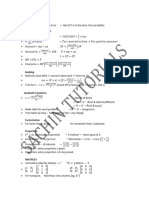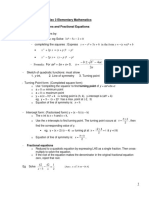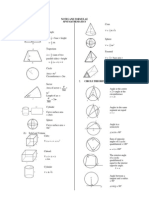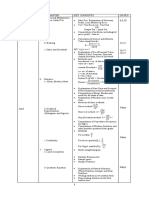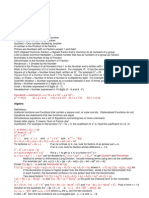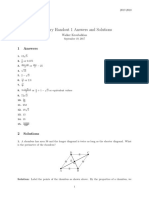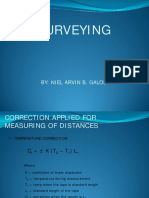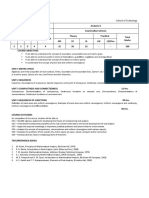SAT Math Basics Comprehensive Overview
Uploaded by
aimanbhutto313SAT Math Basics Comprehensive Overview
Uploaded by
aimanbhutto313UNIVERSITY Generic University
NAME:
SUBJECT: Mathematics
TITLE: SAT Math Basics:
Comprehensive
Overview
SAT Math Basics (In-Depth)
1. Algebra
1.1. Linear Equations
Definition: A linear equation is an equation that makes a straight
line when graphed. It is written in the form of "ax + b = c," where
"a" and "b" are constants, and "x" is the variable you need to solve
for.
How to Solve:
o Combine like terms on both sides of the equation.
o Use inverse operations to isolate the variable (subtract or add,
then multiply or divide).
o Example: For the equation "2x + 5 = 13":
First, subtract 5 from both sides to get "2x = 8."
Next, divide both sides by 2 to solve for "x," giving you
"x = 4."
Graphing: To graph a linear equation, find two points that satisfy
the equation and plot them on a coordinate grid. Draw a line
through these points. The line represents all possible solutions to
the equation.
o Example: For the equation "y = 2x + 3":
When "x" is 0, "y" is 3 (y-intercept).
When "y" is 0, solve "0 = 2x + 3" to find "x" as -1.5 (x-
intercept).
Plot these points and draw the line.
1.2. Systems of Linear Equations
Definition: Systems of linear equations consist of two or more
equations with the same variables. The solution is where the lines
intersect (if at all).
Methods:
o Substitution:
Solve one equation for one variable.
Substitute this value into the other equation.
Solve for the remaining variable.
Example: For the system:
x + y = 10
x-y=4
Solve "x" from the first equation: x = 10 - y
Substitute into the second equation: (10 - y) - y =
4, giving "y" as 3 and "x" as 7.
o Elimination:
Align the equations and add or subtract to eliminate one
variable.
Solve the resulting equation.
Example: For the system:
2x + 3y = 12
x-y=2
Multiply the second equation by 3: 3x - 3y = 6
Add to the first equation: (2x + 3y) + (3x - 3y) =
12 + 6, giving "x" as 3.6 and "y" as 1.6.
1.3. Quadratic Equations
Definition: Quadratic equations have the form "ax^2 + bx + c =
0," where the highest power of the variable is 2.
Quadratic Formula: This formula is used to find the roots of a
quadratic equation when factoring is difficult. It is written as "x = (-b
± √(b^2 - 4ac)) / 2a."
o The term "b^2 - 4ac" is known as the discriminant.
If it is positive, there are two real roots.
If it is zero, there is one real root.
If it is negative, there are no real roots.
o Example: For the equation "x^2 - 4x - 5 = 0":
Calculate the discriminant: (-4)^2 - 4 * 1 * (-5) = 16 +
20 = 36.
Apply the formula to get the roots: x = (4 ± √36) / 2 =
(4 ± 6) / 2, resulting in "x = 5" and "x = -1."
2. Geometry
2.1. Triangles
Types:
o Equilateral Triangle:
All sides and angles are the same. Each angle is 60
degrees.
The height and other special segments are also equal.
Example: For an equilateral triangle with side length 6,
the area can be calculated as approximately "9√3."
o Isosceles Triangle:
Two sides are equal, and the angles opposite these sides
are equal.
Example: For an isosceles triangle with side lengths 5
and a base of 6, use the Pythagorean Theorem to find
the height.
o Scalene Triangle:
All sides and angles are different.
Use the Law of Sines or Law of Cosines to solve it.
2.2. Circles
Arc Length:
o The distance along the curved part of the circle.
o Formula: (Angle in degrees / 360) × (2 × π × Radius)
o Example: For a circle with radius 5 and an angle of 60
degrees, the arc length is approximately "5π/3."
Sector Area:
o The area enclosed by two radii and the arc.
o Formula: (Angle in degrees / 360) × (π × Radius^2)
o Example: For a circle with radius 7 and an angle of 90
degrees, the sector area is approximately "12.25π."
2.3. Angles in Geometry
Sum of Interior Angles in Polygons:
o Formula: (Number of sides - 2) × 180 degrees
o Example: For a pentagon (5 sides), the sum of the interior
angles is "540 degrees."
Regular Polygon:
o Interior Angle: (Sum of Interior Angles) / Number of Sides
o Exterior Angle: 360 degrees / Number of Sides
3. Data Analysis
3.1. Mean
Definition: The average value of a dataset.
Calculation:
o Add all the values together.
o Divide by the number of values.
o Example: For the values 2, 4, 6, 8, and 100, the mean is 24.
3.2. Median
Definition: The middle value in an ordered dataset.
Finding:
o Arrange the values in ascending order.
o Identify the middle value if there is an odd number of values
or average the two middle values if there is an even number.
o Example: For the values 3, 5, 7, 8, 12, 14, the median is 7.5.
3.3. Mode
Definition: The most frequently occurring value in a dataset.
Finding:
o Identify which value appears the most often.
o Example: For the values 1, 2, 2, 3, 3, 3, 4, the mode is 3.
3.4. Range
Definition: The difference between the highest and lowest values.
Calculation:
o Subtract the smallest value from the largest value.
o Example: For the values 15, 20, 35, and 50, the range is 35.
3.5. Standard Deviation
Definition: Measures the amount of variation in a dataset.
Calculation:
o Find the mean of the dataset.
o Calculate the squared differences from the mean.
o Find the average of these squared differences (variance).
o Take the square root of the variance.
o Example: For the dataset 2, 4, 6, and 8, the standard deviation
is approximately 2.24.









